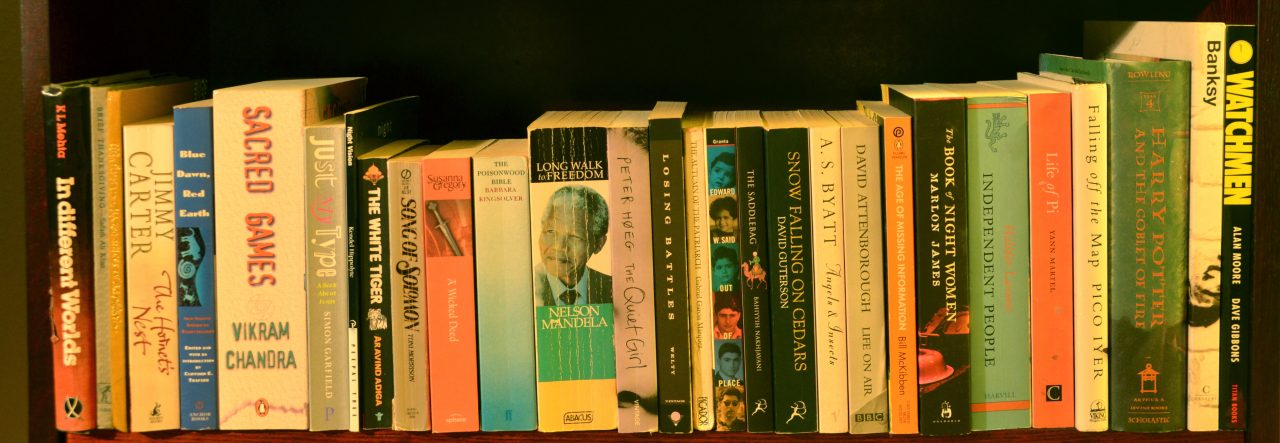Monisha Rajesh is a British journalist and travel writer.
Her first book, Around India in 80 Trains, was selected by The Independent as one of the top ten books on India in 2012.
Monisha’s second book, Around the World in 80 Trains, won the 2020 National Geographic Traveller Book of the Year and was shortlisted for the 2020 Stanford Dolman Travel Book of the Year award.
Monisha has written for Conde Nast Traveller, The Independent, The Sunday Telegraph, The Guardian and The New York Times.
Talking About Books interviewed Monisha about train travel and travel writing.
TAB: What is it that draws to you to train travel?
MR: Over the last decade or so I’ve become more mindful about my carbon footprint and flying unnecessarily. I’ve never been a fan of aeroplanes in general and find them claustrophobic and painful to endure, but with trains I don’t feel anything like that. When travelling by train I can get up, walk around, move seats, hang out in the dining car and not feel like I’m doing anything more than travelling from A to B. When I’m on a train, I’m at my most relaxed and feel like there’s nothing between the world and me.
TAB: The journey for your book Around the World in 80 Trains covered 45,000 miles and 18 countries. How did you prepare for a trip like that?
MR: I think it was about 23 countries in the end. It wasn’t as complicated as it might appear as I bought rail passes for Europe, Japan and the US which made it easy for me to hop on and off trains as and when I wanted without advanced bookings. I also reserved the major journeys such as the Trans-Mongolian and The Canadian at least four months in advance so that I had the major elements in place and then simply sewed in all the other trains in between. I don’t like stringent planning as it takes away the adventure of travel and strips away the freedoms that are so unique to train travel.
TAB: What stood out for you on these trips and what were some of the challenges you faced?
MR: It sounds like a cliché but the kindness of strangers and the willingness of people to chat, share stories, offer help and advice never fails to astound me. No matter what country we were travelling through there was always someone in my compartment offering to interpret conversations, guide us on the best places to eat and drink, and expound on each country’s history or cultural nuances. Challenges mostly came in Russia, when we were met with tangible hostility in the Moscow suburbs where we were the only people of colour for miles and didn’t speak the language, which heightened tensions. Even on board the Trans-Mongolian we were met with cold stares until a young lawyer who spoke English was able to translate for us and melt the iciness.
TAB: In your books, how do you decide what to include and what to leave out?
MR: You have to be strict with yourself. Bad travel-writing tends to be chronological narration that swiftly descends into a holiday diary, which isn’t interesting to a reader. The art of travel-writing is to allow people to see a country and hear from its people through your eyes and ears, as though they’re there themselves. That means including stories and conversations that peel away layers rather than dumping everything onto the ground and making them sift through it. Ultimately the book has to be fun to read and engaging enough for readers to want to stay until the end, so there’s no point in detailing anything that slows the pace or makes them tune out. If a scenario or conversation throws up something specific about a train or a country that readers wouldn’t have otherwise known, then in it goes.
TAB: You are working on a new book. Where does your travel take you to this time?
MR: I’m focusing on the resurgence of night trains, so will be on sleeper trains across a number of different countries again. This time I hope to get across to Australia and South Africa as well as a bit more in Europe.
TAB: What inspired you to start writing?
MR: Nothing in particular. I’ve always kept diaries, written short stories, and enjoyed writing long emails to entertain people and make them laugh which developed into writing for my student newspaper and then pursuing a postgraduate diploma in journalism. I’ve never not written for as long as I can remember so it felt like a natural progression to go into journalism and then segue into travel-writing.
TAB: What would you say to a travel writer starting out?
MR: Find a niche and make it your own. When I set off to write my first book Around India in 80 Trains, I couldn’t think of a single contemporary woman author who wrote about railways, certainly not a woman of colour. It was an area that was and is still dominated by posh white men in red trousers and there didn’t appear to be any room for anyone new—or at least that’s what publishers made me think. However, I honed my craft and became such an up-to-date specialist on railway travel around the world that I rarely have to pitch editors now and instead they come to me to write for them which is a dream position to be in.
TAB: Thank you for sharing your thoughts with us. I’ve enjoyed your books, especially as trains are one of my favourite modes of transport. I’m looking forward to your next book!
Read my reviews of Around the World in 80 Trains and Around India in 80 Trains for Women on the Road.


Pingback: Women Travellers Tell their Stories – Talking About Books
Pingback: Travelling the World: A Woman’s Perspective – Talking About Books